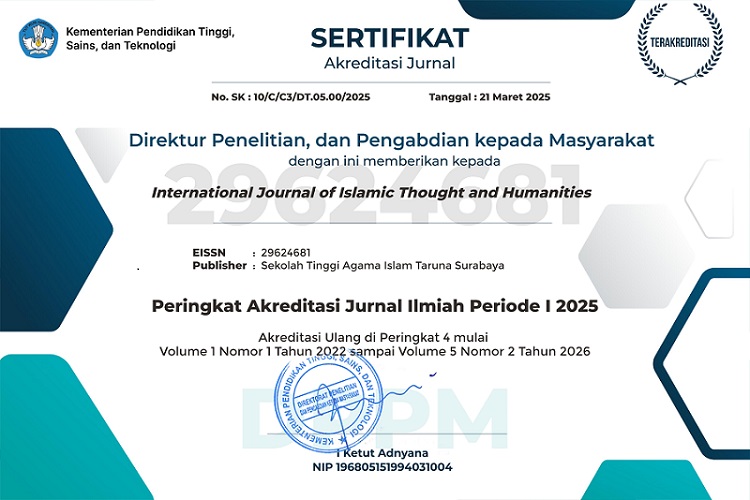Implementation of Pancasila Students Profile through Establishment Values of Indonesian Folktale in Madrasah Ibtidaiyah
DOI:
https://doi.org/10.54298/ijith.v2i2.139Keywords:
Pancasila Students Profile, Indonesian folklore, Characters EducationAbstract
Adolescence is a time when a person is in search of identity, trying to get to know who he really is. because they often get figures or role models from television shows and commercial films as well as youth social media which often imitate styles, languages, foreign cultures so that it can lead to a lack of love for the nation's wealth. By implementing the values that exist in folklore, it aims to instill values and attitudes, as well as changes in behavior that occur after the instillation of values and national character education. Folklore contains: 1) presenting the best characters, and 2) ideal figures for youth role models, becoming a representation and picture of social reality, including local wisdom and the social reality of the Indonesian people. Folklore can process the psychology and emotions of the reader. Dramatized plots, interesting storylines, giving surprises and curiosity, characterizations with firm characteristics, language that is easy to digest. This research uses qualitative research to prove that in Indonesian folklore there is the concept of Pancasila students increasing students' reading motivation. , emphasizing student activity and learning outcomes.
Downloads
References
Alfin, J., Zuhri, AM, Rosyidi, Z., & Stelmachowska, DM (2019, January). ISLAMOPHOIA DISCOURSE AND PERCEPTIONS OF INDONESIAN ISLAM THROUGH LANGUAGE STUDY AMONG POLAND STUDENTS. In International Conference on Emerging Media.
Asrul, A., Saragih, AH, & Mukhtar, M. (2022). Learning evaluation.
Azis, Y., Metafisika, K., Lestari, F. A. A., & Asistiana, L. (2022). Analysis of validity, practicality, and readability of islamic STEAM activity storybook for early childhood. Al-Athfaal: Jurnal Ilmiah Pendidikan Anak Usia Dini, 5(1), 63–75.
Emzir, Educational Research Methodology: Quantitative and Qualitative, Rosdakarya Youth, Bandung, 2012
Fimansyah, W., & Kumalasari, D. (2015). Instilling nationalist values through learning history at SMA Kebangsaan Yogyakarta. ISTORIA Journal of History Education and Science, 11(1).
Hutagalung, AL (2022). Development of Teaching Materials for Writing Sociocultural-Based Folklore Texts for Class X High School Indonesian Language Subjects (Doctoral dissertation, Faculty of Teacher Training and Education, Islamic University of North Sumatra).
Indianarti, W. (2017). Values that form character in folklore from the origins of Watu Dodol. Jentera: Journal of literary studies, 6(1), 26-41.
Junia, NMIJI, & Sujana, IW (2023). Development of an interactive e-module based on Pancasila student profiles in science and science subjects, material on Indonesian cultural wealth for fourth grade elementary school students. MIBAR PGSD Undiksha, 11(1).
Masud, S., Abdillah, H., Munfaati, K., Erfansyah, N. F., & Metafisika, K. (2023). Embedding STEM Learning with Islamic Values and Character Education in the Storybook. International Journal of STEM Education for Sustainability, 3(2), 297–318.
Metafisika, K., Azizah, R. N., & Fitriyah, F. K. (2022). The The Development Process of Islamic STEAM Activity Storybooks for Early Childhood. Child Education Journal, 4(1), 1–12.
Metafisika, K., Zahroh, L., & Utomo, K. B. (2022). Buku Cerita Aktivitas STEM Islami sebagai Media Penguatan Literasi dan Profil Pelajar Pancasila. Proceedings of Annual Conference for Muslim Scholars, 6(1), 722–727.
Nugroho, TT, Untari, MFA, & Nafiah, U. (2021). APPLICATION OF THE FLIPPED CLASSROOM MODEL IN IMPROVING LEARNING OUTCOMES IN INDONESIAN LANGUAGE THEMES OF OBJECTS AROUND US IN FIFTH GRADE STUDENTS OF SD N 02 KEBONAGUNG FOR THE 2020/2021 ACADEMIC YEAR. Malih Peddas (Primary Education Scientific Magazine), 11(1), 66-79.
Nurhadi, A. (2020). INTEGRATION OF IMPLEMENTING NATIONALISM VALUES THROUGH LEARNING INDONESIAN LANGUAGE IN GUNUNGKIDUL DISTRICT SMP. National Defense Education, 30, 35.
Pujiono, A. (2022). Analysis of the Balance of Cognitive, Affective and Psychomotor Domains in the Ecological Content of the High School Christian Religious Education Curriculum. REAL DIDACHE: Journal of Christian Education, 2(2), 73-89.
Rahmadyansyah, R. (2015). Internalization of Parental Exemplary Values in Preschool Children. MUDARRISUNA Journal: Media for Islamic Religious Education Studies, 5(2), 357-376.
Pamungkas, MI (2023). Modern Muslim Morals: Building the Character of the Young Generation. Marja.
Sugiyono, Understanding Qualitative Research, Alfabeta, Bandung, 2005
Sujono, I., Malaka, Z., Istifhama, L., Nasiri, N., & Anah, S. (2022). Efforts to Strengthen Islamic Moderation of Islamic Religious Universities in Indonesia. Proceedings of the 6th Batusangkar International Conference, BIC 2021, 11 -12 October, 2021, Batusangkar-West Sumatra, Indonesia. https://doi.org/10.4108/eai.11-10-2021.2319459
Tafonao, T. (2018). The role of learning media in increasing student interest in learning. Journal of educational communication, 2(2), 103-114.
Downloads
Published
How to Cite
Issue
Section
License
Copyright (c) 2023 Rosa Dewi, Gamayanti Novi Rahmawati, Jauharoti Alfin, Nasiri Nasiri

This work is licensed under a Creative Commons Attribution-ShareAlike 4.0 International License.
Authors who publish with this journal agree to the following terms:
- Authors retain copyright and grant the journal right of first publication with the work simultaneously licensed under a Creative Commons Attribution-ShareAlike 4.0 that allows others to share the work with an acknowledgement of the work's authorship and initial publication in this journal.
- Authors are able to enter into separate, additional contractual arrangements for the non-exclusive distribution of the journal's published version of the work (e.g., post it to an institutional repository or publish it in a book), with an acknowledgement of its initial publication in this journal.
- Authors are permitted and encouraged to post their work online (e.g., in institutional repositories or on their website) prior to and during the submission process, as it can lead to productive exchanges, as well as earlier and greater citation of published work (See The Effect of Open Access).


















